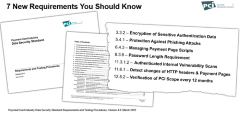

Three Technologies to Look for in a Secure Payment Gateway
Why EMV, P2PE and Tokenization Should be Included
Ensuring the security of payment transactions is a must for businesses and consumers alike. A secure payment gateway serves as the cornerstone of this trust, facilitating safe and efficient transactions. To safeguard sensitive payment data, it’s essential to implement robust technologies within your payment infrastructure. Three critical technologies to consider are EMV, Point-to-Point Encryption (P2PE), and Tokenization.
EMV: Securing Against Counterfeit Cards
EMV, which stands for Europay, Mastercard, and Visa, is a global standard for credit and debit card payments. Established in 1994 by EMVCo, EMV technology has become a fundamental component of secure payment gateways worldwide. The primary purpose of EMV is to combat counterfeit card fraud by embedding microprocessor chips in payment cards.
These EMV chips generate a unique transaction code, known as a dynamic cryptogram, for each payment. This dynamic code makes it exceedingly difficult for fraudsters to duplicate or clone the card, thereby significantly reducing the risk of counterfeit fraud. The adoption of EMV technology has led to a substantial decrease in card-present fraud cases globally.
EMV 3D Secure is a globally accepted authentication solution designed to make eCommerce payment processing more secure in real-time by providing an additional layer of security. It enables the exchange of data between the merchant, card issuer and when necessary, the cardholder to validate that the transaction is being initiated by the rightful owner of the account.
Common Misconceptions:
- EMV Eliminates All Fraud: While EMV is effective against counterfeit card fraud, it does not address card-not-present (CNP) fraud, which occurs in online transactions.
- EMV is Mandatory Everywhere: Although widely adopted, EMV implementation varies by region and is not universally mandated.
Point-to-Point Encryption (P2PE): Protecting Data in Transit
Point-to-Point Encryption (P2PE) is a security measure that encrypts cardholder data from the point of entry (e.g., a payment terminal) to the point of decryption, typically within a secure payment gateway. This ensures that sensitive information remains encrypted throughout its journey, rendering it unreadable to unauthorized parties.
Implementing P2PE involves using secure encryption devices and managing cryptographic keys in compliance with stringent standards set by the Payment Card Industry Security Standards Council (PCI SSC). By adopting a PCI-validated P2PE solution, merchants can significantly reduce the scope of their PCI Data Security Standard (PCI DSS) compliance requirements, leading to cost savings and enhanced security.
Common Misconceptions:
- P2PE and End-to-End Encryption (E2EE) are the Same: While both encrypt data, P2PE is a standardized, PCI-validated solution with specific requirements, whereas E2EE is a broader term without a single governing standard.
- P2PE is Only for Large Enterprises: Businesses of all sizes can benefit from P2PE, as it provides robust security and can simplify PCI compliance.
There are three high-level requirements that every P2PE solution must offer:
- The card data must be encrypted using strong cryptography
- The encryption must be performed within a P2PE-compliant device
- It must not be feasible to decrypt the data within the merchant environment
As a result of these requirements, it becomes physically improbable to access card data prior to encryption; it becomes computationally infeasible to derive captured card data using brute-force methods; and it becomes logically unattainable to access the decryption keys in order to decrypt directly.
Through this process, P2PE performs the function of devaluing the cardholder data in the eyes of any hacker who may otherwise seek to access this information within the merchant’s software, systems, and network, therefore securing card data in flight.
Tokenization – Securing Card Data at Rest
Finally, there are merchants who must perform certain customer billing functions, such as delayed charges, subscriptions, refunds, or credits, which require credit card information. Some merchants may have also used cardholder data as a means to track consumer behavior (although this practice is generally prohibited). Traditionally, these operations require the merchant to store sensitive credit card information so that it can be accessible for future use. Unfortunately, this also leaves a “treasure” of stored credit card data that may be stolen. For that reason, the efforts required to fully protect stored card data (PCI DSS Requirement 3) can be quite extensive and expensive.
Tokenization is the technology where secure card data storage is centralized and a different value is used to represent the original cardholder data.
In a secure payment gateway, tokenization minimizes the risk associated with data breaches, as compromised tokens do not reveal actual card information. Additionally, since tokens are meaningless outside the system, they reduce the attractiveness of stored data to potential attackers.
When re-used, the token is sent to the tokenization provider, where the original cardholder data is retrieved, decrypted, and utilized. A compliant third-party provider may handle this process, including cryptographic storage encryption. Unlike P2PE, tokens are designed for safe storage and are not typically a reversible encrypted form of the original PAN. Tokens may resemble a credit card number, retain non-sensitive portions, or be entirely different. In some cases, they are encrypted cardholder data, but more often, they serve as random reference numbers linked to stored information in a token vault. Tokenization can be managed by the gateway, a service provider, the acquirer, the card brand, or the issuing bank.
To take full advantage of the benefits of tokenization, PCI SSC recommends that merchants tokenize sensitive data as quickly as possible, replace cardholder data with tokens wherever it is stored, and use services that do not provide a mechanism to “detokenize” data, as this presents another avenue that may be exploited. In each case, the merchant must still observe PCI compliance requirements for systems that store, transmit, or process card data before the data has been tokenized.
Common Misconceptions:
- Tokenization and Encryption are Redundant: While both protect data, tokenization secures stored data by replacing it with tokens, whereas encryption protects data in transit by converting it into a coded format.
- Tokens Can Be Reverse-Engineered: Properly implemented tokenization ensures that tokens cannot be reverse-engineered to reveal the original card information.
Integrating These Technologies into Your Secure Payment Gateway
For businesses aiming to enhance their payment security, integrating EMV, P2PE, and Tokenization into their payment gateway is crucial. These technologies work in tandem to protect data at various stages of the transaction process:
- EMV secures the initial card-present transaction by generating dynamic authentication codes.
- P2PE ensures that card data remains encrypted during transmission, preventing interception by malicious actors.
- Tokenization protects stored card information by replacing it with non-sensitive tokens, reducing the impact of potential data breaches.
By adopting a secure payment gateway that incorporates these technologies, businesses can significantly reduce the risk of fraud, protect customer data, and maintain compliance with industry standards.
Additional Considerations for a Secure Payment Gateway
Beyond implementing EMV, P2PE, and Tokenization, businesses should consider the following factors to ensure a comprehensive secure payment gateway:
3D Secure Authentication
3D Secure is an additional layer of authentication designed to prevent unauthorized online transactions. It involves the exchange of data between the merchant, card issuer, and, when necessary, the cardholder, to validate that the transaction is being initiated by the rightful owner of the account. Implementing 3D Secure can reduce fraudulent transactions and shift liability away from merchants.
Compliance with PCI DSS
Maintaining compliance with the Payment Card Industry Data Security Standard (PCI DSS) is essential for any business handling card payments. Compliance involves adhering to a set of security standards designed to protect card information during and after a financial transaction. Utilizing a secure payment gateway that supports PCI DSS compliance can help businesses meet these requirements more efficiently.
Regular Security Audits and Updates
The threat landscape for payment processing is continually evolving. Regular security audits and timely updates to your payment gateway are vital to identify vulnerabilities and implement necessary patches. Partnering with a payment gateway provider that offers ongoing support and updates can help maintain the security and integrity of your payment processing system.
Conclusion
Incorporating EMV, Point-to-Point Encryption, and Tokenization into your secure payment gateway is essential for protecting sensitive payment data and maintaining customer trust. By understanding and implementing these technologies, along with additional security measures like 3D Secure authentication and PCI DSS compliance, businesses can create a robust payment security framework that safeguards against fraud and data breaches.


